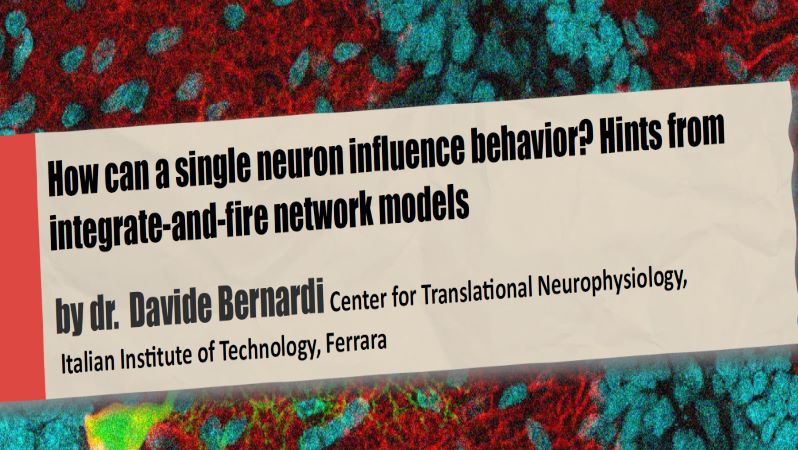by dr. Davide Bernardi, Center for Translational Neurophysiology of Speech and Communication @ Istituto Italiano di Tecnologia (Ferrara, Italy)
When: October 6th, 2022 – 3:15 pm
Where: Sala Seminari, VIMM. Recording available on Mediaspace
Abstract: There is increasing experimental evidence that the activity of single cortical neurons can make a difference to the brain. One particularly striking example is that rats can be trained to respond to the stimulation of a single cell in the barrel cortex. It is not clear how this finding can be reconciled with the usual textbook view that only large neuronal populations can reliably encode information, as is often argued on the basis of the large noise and chaotic dynamics of cortical networks. This talk shows how this problem can be framed theoretically by studying the stimulation of a single neuron in a large random network of integrate-and-fire neurons. In this model, chaotic noise-like fluctuations arise naturally from the combination of spiking dynamics and the random interactions.
A combination of numerical simulations and analytical calculations demonstrates how a simple readout strategy can be used to detect the single neuron stimulation in the activity of a readout subpopulation. Furthermore, I will discuss how a second integrate-and-fire network can perform the readout in a way that is both more realistic and more efficient. In the final part, I will argue how such a readout network, tuned to approximate a differentiator circuit, can detect the single-neuron stimulation in a more biologically detailed model. Most importantly, the effect size does not depend appreciably on the duration or intensity of a constant stimulation, whereas the response probability increases significantly upon injection of an irregular current, in agreement with experimental findings.
Taken together, these results hint at a possible general readout strategy: feed-forward and recurrent inhibitory synapses ensure both the macroscopic stability and the sensitivity to single-neuron perturbation through a selective imbalance in the topological (spatial) and temporal sense.
Short bio: Born in Padova, Davide Bernardi obtained a diploma as a cellist at the Conservatorio di Musica di Padova and a B.A. in physics at the University of Padova. After spending several years as a chamber music and orchestra player, he continued his studies at the Freie Universität Berlin (Germany), where he graduated in physics. As a member of the graduate school “Sensory computation in neural systems” based at the Bernstein Center for Computational Neuroscience Berlin, he achieved a PhD in theoretical physics at the Humboldt University of Berlin with highest distinction (summa cum laude). He currently holds a Post-Doc position at the Center for Translational Neurophysiology of Speech and Communication hosted by the Italian Institute of Technology and the University of Ferrara.


